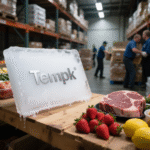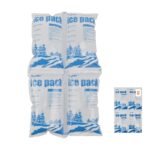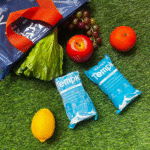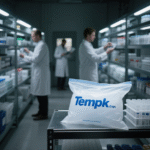Le transport des vaccins en toute sécurité nécessite de maintenir un contrôle précis de la température tout au long du processus d'expédition.. Les packs de glace carbonique jouent un rôle essentiel à cet égard, offrant une méthode fiable pour conserver les vaccins à des températures ultra-basses pendant le transport. Alors que la logistique de la chaîne du froid évolue avec les nouvelles technologies et normes réglementaires, comprendre comment utiliser efficacement les packs de glace carbonique devient essentiel pour garantir l’efficacité du vaccin. Cet article traite de l'importance de blocs de glace carbonique dans le transport des vaccins, leurs avantages, et les bonnes pratiques pour leur utilisation.
-
Comment les blocs de glace carbonique maintiennent-ils des températures ultra-basses pendant le transport des vaccins?
-
Quels sont les avantages de l’utilisation de la neige carbonique dans la logistique de la chaîne du froid des vaccins?
-
Quelles sont les meilleures pratiques d’utilisation des blocs de glace carbonique lors du transport des vaccins?
-
À quels défis les blocs de glace carbonique répondent-ils lors du transport des vaccins?
Comment les packs de glace carbonique maintiennent-ils des températures ultra-basses pendant le transport des vaccins?
Les packs de glace carbonique sont constitués de dioxyde de carbone solide (Co₂), et ils maintiennent des températures aussi basses que -78,5°C (-109.3°F). Contrairement aux packs de glace traditionnels, la neige carbonique se sublime directement d'un solide à un gaz, créant un effet rafraîchissant sans laisser de résidu liquide. Ce processus de sublimation aide la glace carbonique à maintenir un refroidissement constant et fiable pour les vaccins nécessitant une congélation profonde., comme les vaccins à ARNm.
Avantage de base: Les blocs de glace carbonique sont idéaux pour transporter des vaccins qui doivent rester à des températures inférieures à zéro pendant de longues périodes., ce qui les rend parfaits pour les expéditions long-courriers ou internationales.
Comment fonctionne la sublimation dans la glace carbonique?
Comme la glace sèche sublime, il absorbe la chaleur de son environnement, garder l'environnement clos au froid. Le dioxyde de carbone créé au cours du processus s'échappe par les évents du conteneur.. Cette méthode de refroidissement évite les risques de contamination associés à l'eau liquide et garantit que les vaccins restent dans les plages de température requises..
| Aspect | Packs de glace sec | Packs de glace traditionnels |
|---|---|---|
| Entretien de température | Températures ultra-faibles (-78.5°C) | Refroidissement souvent irrégulier |
| Sécurité | Non toxique, aucun risque d'humidité | Potentiel de contamination |
| Rentabilité | Rentable pour les expéditions longues | Peut être inutile et coûteux |
Avantages de l'utilisation de blocs de glace carbonique pour le transport des vaccins
Les packs de glace carbonique offrent plusieurs avantages distincts pour transporter les vaccins en toute sécurité:
1. Contrôle de température fiable
Les packs de glace sèche fournissent un effet de refroidissement stable et continu tout au long du processus d'expédition, veiller à ce que les vaccins soient conservés à la température requise du début à la fin. Cela permet d’éviter tout risque de détérioration et de maintenir l’activité des vaccins..
2. Conformité aux réglementations
Le transport des vaccins est fortement réglementé pour garantir la sécurité. La glace carbonique répond à ces normes strictes, s'assurer que les vaccins restent dans les plages de température requises et que l'emballage est conforme aux exigences réglementaires fixées par des agences comme la FDA et l'OMS.
3. Sûr et sécurisé
La glace carbonique peut être utilisée sans danger dans les envois médicaux, car il est non toxique et ne produit pas d'eau susceptible de contaminer les vaccins. En outre, le processus de sublimation de la glace sèche garantit qu'il n'y a aucun liquide résiduel qui pourrait potentiellement endommager les matériaux sensibles.
4. Rentable
Par rapport à d’autres méthodes de transport à température contrôlée, la glace sèche constitue une solution efficace et rentable pour la logistique de la chaîne du froid. Il est particulièrement utile pour les expéditions longue distance où les conteneurs réfrigérés traditionnels seraient beaucoup plus chers..
Meilleures pratiques d’utilisation des packs de glace carbonique pour le transport des vaccins
Bien que les packs de glace carbonique soient efficaces, leur succès dépend d'une utilisation appropriée. Voici quelques bonnes pratiques pour garantir leur fonctionnement optimal pendant le transport des vaccins:
1. Choisir la bonne quantité de glace carbonique
La quantité de neige carbonique utilisée dépend de la durée de l’envoi et des exigences spécifiques de température du vaccin.. Il est important de calculer soigneusement la quantité de neige carbonique pour maintenir la température requise pendant toute la durée du transport.. Un sous-emballage pourrait entraîner des excursions de température, tandis qu'un suremballage peut entraîner des coûts inutiles.
2. Emballage approprié
Utilisez des emballages isothermes pour améliorer l’efficacité de la neige carbonique. Les conteneurs isothermes aident à conserver la température froide plus longtemps, s'assurer que la neige carbonique ne se sublime pas trop rapidement. L'emballage doit également permettre au gaz CO₂ de s'échapper en toute sécurité pour éviter l'accumulation de pression..
3. Surveillance de la température
Mettre en œuvre des systèmes de surveillance de la température capables de suivre et de signaler la température interne de l'expédition en temps réel. Cela garantit que les vaccins sont toujours conservés dans la plage de température requise tout au long du transport..
4. Conformité aux réglementations
Respectez toujours les réglementations locales et internationales lors de l’expédition de neige carbonique. Cela inclut un étiquetage approprié, documentation, et emballage selon les directives IATA et DOT. La conformité réglementaire contribue à garantir la sécurité de votre envoi et à éviter les pénalités..
Défis liés au transport des vaccins et comment les packs de glace carbonique aident à les surmonter
1. Maintenir le contrôle de la température sur de longues distances
Le transport de vaccins sur de longues distances, parfois à l'échelle internationale, présente des défis pour maintenir la température requise.. La glace carbonique est une excellente solution, car il peut conserver les vaccins congelés pendant 24 à 72 heures, selon conditions et emballage.
2. Éviter la contamination
Les blocs de glace traditionnels introduisent souvent de l'humidité, ce qui peut provoquer une contamination ou endommager l’emballage du vaccin. La glace carbonique élimine ce risque en sublimant sans créer de résidu liquide.
3. Respect des normes réglementaires
L’environnement réglementaire du transport des vaccins est complexe. La glace carbonique répond aux normes les plus strictes pour les envois médicaux, s'assurer que les vaccins sont transportés en toute sécurité et dans la plage de température requise.
2025 Tendances dans le transport des vaccins
Alors que l’industrie du transport des vaccins s’adapte aux nouveaux défis et technologies, plusieurs tendances émergentes devraient façonner l’avenir de l’utilisation de la glace carbonique:
Surveillance avancée de la température
Les systèmes de suivi de la température compatibles IoT sont de plus en plus courants. Ces systèmes fournissent des données en temps réel, améliorer la capacité de surveiller les expéditions de vaccins et de garantir leur intégrité tout au long du processus de transit.
Durabilité dans la chaîne du froid
Avec un accent croissant sur la durabilité, des alternatives plus écologiques à la neige carbonique traditionnelle sont en cours de développement. Les entreprises investissent dans des technologies d’isolation biodégradable et de captage du carbone pour réduire leur empreinte environnementale.
Solutions personnalisées pour des besoins spécialisés
À mesure que les formulations de vaccins se diversifient, il existe une demande croissante de solutions de glace carbonique personnalisées adaptées aux exigences de température spécifiques. Ces solutions deviendront de plus en plus importantes pour garantir que chaque vaccin soit transporté dans les conditions optimales.
Questions courantes sur le transport des vaccins avec des packs de glace carbonique
Quelle est la quantité idéale de neige carbonique pour le transport des vaccins?
La quantité idéale de neige carbonique dépend de la taille de l'envoi et de la durée du transit.. En général, 5-10 livres de glace carbonique par 24 des heures de délai d'expédition sont recommandées pour le transport longue distance.
La glace carbonique peut-elle être utilisée pour tous les types de vaccins?
Non, la neige carbonique convient particulièrement aux vaccins qui nécessitent une congélation profonde. Pour les vaccins nécessitant des conditions réfrigérées (2° C - 8 ° C), packs de gel ou matériaux à changement de phase (PCMS) sont de meilleures alternatives.
Comment dois-je manipuler la neige carbonique en toute sécurité?
Utilisez toujours des gants et des lunettes isolants lorsque vous manipulez de la neige carbonique. Assurez-vous que les conteneurs sont correctement ventilés pour permettre au CO₂ de s'échapper., et stockez la glace carbonique dans un endroit bien ventilé pour éviter l'asphyxie.
Conclusion et recommandations
Le transport des vaccins avec des blocs de glace carbonique est crucial pour maintenir la température requise, assurer l'efficacité, et répondant aux normes réglementaires. En suivant les meilleures pratiques, calculer la quantité correcte de neige carbonique, et en respectant les règles de sécurité, les parties prenantes peuvent garantir que les vaccins sont livrés de manière sûre et efficace.
Astuce exploitable:
Avant l'expédition, calculez toujours vos besoins en glace carbonique, choisissez le bon emballage, et surveillez les températures pour vous assurer que vos vaccins restent à la bonne température tout au long du processus de transit..
À propos du tempk
Et tempk, nous sommes spécialisés dans la fourniture de solutions avancées de glace carbonique adaptées aux industries pharmaceutique et biotechnologique. Nos produits garantissent la fiabilité, sûr, et un transport de vaccins conforme, soutenir l’effort mondial visant à fournir des vaccins efficaces. Contactez-nous dès aujourd'hui pour une solution de chaîne du froid personnalisée.
























